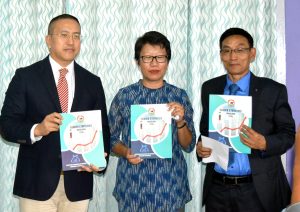Nagaland
Nagaland gender statistics publication seeks to promote parity

Our Correspondent
Kohima, Oct. 9 (EMN): While the Indian Constitution not only grants equality to women, but also empowers the state to adopt measures of positive discrimination in favour of women, participation of women in decision making in the state has been very low, as latest statistics suggest.
As per the ‘Gender Statistics Nagaland 2016’ – released by Commissioner-Secretary of Economics and Statistics, Himato Zhimomi at Kohima on Oct. 9 – statistics show only two women who contested in the general elections from 1964-2014.
Data also shows no representation of women in the state legislative assembly, Lok Sabha, Rajya Sabha, and in the state council of ministers in Nagaland since the first general elections.
With the increase in demand for gender statistics over the years on account of the efforts of the government and various international agencies to bring about gender parity and equity through ‘gender empowerment policies’, the department of Economics and Statistics has released the first gender-wise publication.
Secretary of Economics and Statistics, Kevileno Angami said recognising the demand for gender statistics over the years, the department has embarked on the exercise to collect and collate gender-wise disaggregate data.
Although the publication throws light on the status of both men and women in different fields, she informed that focus is placed on socio-economic status of women, on issues of violence against women, political participation of women, status of women in the labour force, employment, health and education sectors to underscore the outcome of women specific programmes to bring them at par with men.
The publication also highlights the impact of government intervention programmes specific to men and women to enable policy makers and planners to formulate suitable evidence-based equitable plans and gender sensitive programmes.
Population (sex ratio)
Over the last 40 years, data shows considerable improvement in sex ratio in the district of Kohima (22.27%), Mokokchung (10.91%) and Dimapur (7.61%). However, the sex ratio worsened in the districts of Peren (-3.28%), Wokha (-1.22%) and Mon (-0.44%).
Literacy rate
The last decade has shown an increased in the literacy rate of females by 14.61% which stands at 76.11% as per Census 2011 as compared to 61.5% during Census 2001. Among the districts, Mokokchung recorded the highest female literacy rate of 91% while Mon district has the lowest literacy rate at 52.6%.
Data shows the gap in literacy rates of males and females is low in the district of Mokokchung, Zunheboto and Longleng and high in the district of Phek, Kiphire and Peren.
Participation in economy
As per Census 2011, female main workers and marginal workers constituted 67.8% and 29.9% respectively to total population, while the workforce participation rate at Nagaland is 44.7% for females and 53.4% for males.
Data indicates an increase of women employed in organised sectors over the years to 23.50% in public sector and 48.60% in private sector during 2014-14 as compared to 18.23% and 35.02% during 2005-06.
Employment Census Report of DES Nagaland in 2001 shows female employees comprised of 21.51% which slightly increased to 22.46% in 2014.
Crimes
Though Nagaland does not conform to the general perception of women status in India, there are however other forms of domestic violence like abuse, rape and molestation etc., which are on the rise and are being reported in the recent years.
Data shows 23 cases of rape registered during 2006 which has increased to 35 during 2015. 92 cases of crime against women were registered in Nagaland in 2015 with Dimapur district having the highest numbers of cases followed by Kohima. 35 cases of rapes incidents were recorded as highest followed by kidnapping and abduction with 30 registered cases.
Seventeen women were arrested under different IPC crimes during 2015 for cases relating to kidnapping, abduction, murder, robbery and other IPC crimes related. In 2015, 42 women were arrested under special and local laws of which 11 were arrested under Immoral Traffic Act, nine under NDPS Act, three under Explosives Act and the rest under SLL crimes.

